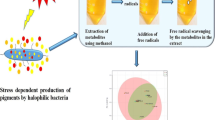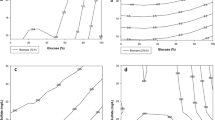Abstract
Hypersaline ecosystems offer unique habitats to microbial populations capable of withstanding extreme stress conditions and producing novel metabolites of commercial importance. Herein, we have characterized for the first time the production of bioactive pigments from newly isolated halophilic bacterial species. Halophilic bacteria were isolated from Khewra Salt Range of Pakistan. Three distinctly colored isolates were selected for pigment production. Selected colonies were identified as Aquisalibacillus elongatus MB592, Salinicoccus sesuvii MB597, and Halomonas aquamarina MB598 based on morphological, biochemical, and physiological evidences as well as 16S rRNA analysis. The optimum pigment production observed at mesophilic condition, nearly neutral pH, and moderate salinity was validated using response surface methodology. Different analytical techniques (UV spectroscopy, infrared spectroscopy, and HPLC) characterized these purified pigments as derivatives of bacterioruberin carotenoids. Antioxidant activity of pigments revealed up to 85% free-radical scavenging activity at the concentration of 30 µg ml−1. Pigments also showed significant antimicrobial activity against Bacillus subtilis, Bacillus pumilus, Enterococcus faecalis, Bacillus cereus, Klebsiella pneumoniae, Alcaligenes faecalis, Pseudomonas geniculata, Enterococcus faecium, Aspergillus fumigatus, Aspergillus flavus, Fusarium solani, and Mucor spp., suggesting potential biomedical applications.








Similar content being viewed by others
References
Alihosseini F, Ju KS, Lango J, Hammock BD, Sun G (2008) Antibacterial colorants: characterization of prodiginines and their applications on textile materials. Biotechnol Prog 24(3):742–747
Balouiri M, Sadiki M, Ibnsouda SK (2016) Methods for in vitro evaluating antimicrobial activity: a review. J Pharm Anal 6(2):71–79
Bhat MR, Marar T (2015) Media optimization, extraction and partial characterization of an orange pigment from Salinicoccus sp. MKJ 997975. Int J Life Sci Biotech Pharm Res 4(2):85–89
Chen CW, Hsu SH, Lin MT, Hsu YH (2015) Mass production of C50 carotenoids by Haloferax mediterranei in using extruded rice bran and starch under optimal conductivity of brined medium. Bioprocess Biosyst Eng 38(12):2361–2367
Cheng HR, Jiang N (2006) Extremely rapid extraction of DNA from bacteria and yeasts. Biotechnol Lett 28(1):55–59
de la Vega M, Sayago A, Ariza J, Barneto AG, León R (2016) Characterization of a bacterioruberin-producing Haloarchaea isolated from the marshlands of the Odiel river in the southwest of Spain. Biotechnol Prog 32(3):592–600
Dikshit R, Tallapragada P (2014) Statistical optimization of pigment production by Monascus sanguineus under stress condition. Prep Biochem Biotechnol 44(1):68–79
Khanafari A, Khavarinejad D, Mashinchian A (2010) Solar salt lake as natural environmental source for extraction of halophilic pigments. Iran J Microbiol 2(2):103–109
Kirti K, Amita S, Priti S, Jyoti S (2014) Colorful world of microbes: carotenoids and their applications. Adv Biol 2014:837891. https://doi.org/10.1155/2014/837891
Kusmita L, Mutiara EV, Nuryadi H, Pratama PA, Wiguna AS, Radjasa OK (2017) Characterization of carotenoid pigments from bacterial symbionts of soft-coral Sarcophyton sp. from North Java Sea. Int Aquat Res 9(1):61–69
Lapenda JC, Silva PA, Vicalvi MC, Sena KXFR, Nascimento SC (2015) Antimicrobial activity of prodigiosin isolated from Serratia marcescens UFPEDA 398. World J Microbiol Biotechnol 31(2):399–406
Li F, Xue F, Yu X (2017) GC–MS, FTIR and Raman analysis of antioxidant components of red pigments from Stemphylium lycopersici. Curr Microbiol 74:532. https://doi.org/10.1007/s00284-017-1220-3
Martin A, McMinn A (2018) Sea ice, extremophiles and life on extra-terrestrial ocean worlds. Int J Astrobiol 17(1):1–16
Naziri D, Hamidi M, Hassanzadeh S, Tarhriz V, Zanjani BM, Nazemyieh H, Hejazi MA, Hejazi MS (2014) Analysis of carotenoid production by Halorubrum sp. TBZ126; an extremely halophilic archeon from Urmia Lake. Adv Pharm Bull 4(1):61–67
Rao N, Prabhu M, Xiao M, Li WJ (2017) Fungal and bacterial pigments: secondary metabolites with wide applications. Front Microbiol 8:1113. https://doi.org/10.3389/fmicb.2017.01113
Rezaeeyan Z, Safarpour A, Amoozegar MA, Babavalian H, Tebyanian H, Shakeri F (2017) High carotenoid production by a halotolerant bacterium, Kocuria sp. strain QWT-12 and anticancer activity of its carotenoid. EXCLI J 16:840–851
Rodrigo-Baños M, Garbayo I, Vílchez C, Bonete MJ, Martínez-Espinosa RM (2015) Carotenoids from Haloarchaea and their potential in biotechnology. Mar drugs 13(9):5508–5532
Sowmya R, Sachindra NM (2015) Carotenoid production by Formosa sp. KMW, a marine bacteria of Flavobacteriaceae family: influence of culture conditions and nutrient composition. Biocatal Agric Biotechnol 4(4):559–567
Surwase SN, Jadhav SB, Phugare SS, Jadhav JP (2013) Optimization of melanin production by Brevundimonas sp. SGJ using response surface methodology. Biotech 3(3):187–194
Sutthiwong N, Fouillaud M, Valla A, Caro Y, Dufossé L (2014) Bacteria belonging to the extremely versatile genus Arthrobacter as novel source of natural pigments with extended hue range. Food Res Int 65:156–162
Tamura K, Stecher G, Peterson D, Filipski A, Kumar S (2013) MEGA6: molecular evolutionary genetics analysis Version 6.0. Mol Biol Evol 30:2725–2729
Tuli HS, Chaudhary P, Beniwal V, Sharma AK (2015) Microbial pigments as natural color sources: current trends and future perspectives. J Food Sci Technol 52(8):4669–4678
Venil CK, Zakaria ZA, Ahmad WA (2013) Bacterial pigments and their applications. Process Biochem 48(7):1065–1079
Yang Y, Yatsunami R, Ando A, Miyoko N, Fukui T, Takaichi S, Nakamura S (2015) Complete biosynthetic pathway of the C50 carotenoid bacterioruberin from lycopene in the extremely halophilic archaeon Haloarcula japonica. J Bacteriol 197(9):1614–1623
Yatsunami R, Ando A, Yang Y, Takaichi S, Kohno M, Matsumura Y, Ikeda H, Fukui T, Nakasone K, Fujita N, Sekine M, Takashina T, Nakamura S (2014) Identification of carotenoids from the extremely halophilic archaeon Haloarcula japonica. Front Microbiol 5:100. https://doi.org/10.3389/fmicb.2014.00100
Zhou B, Wang J, Pu Y, Zhu M, Liu S, Liang S (2009) Optimization of culture medium for yellow pigments production with Monascus anka mutant using response surface methodology. Eur Food Res Technol 228(6):895–901
Acknowledgements
Authors are thankful to Dr. J. Chris Blazier (Institute of Genome Sciences and Society, Texas A&M University) for editing the final manuscript.
Author information
Authors and Affiliations
Corresponding author
Additional information
Communicated by M. Moracci.
Publisher's Note
Springer Nature remains neutral with regard to jurisdictional claims in published maps and institutional affiliations.
Electronic supplementary material
Below is the link to the electronic supplementary material.
Rights and permissions
About this article
Cite this article
Fariq, A., Yasmin, A. & Jamil, M. Production, characterization and antimicrobial activities of bio-pigments by Aquisalibacillus elongatus MB592, Salinicoccus sesuvii MB597, and Halomonas aquamarina MB598 isolated from Khewra Salt Range, Pakistan. Extremophiles 23, 435–449 (2019). https://doi.org/10.1007/s00792-019-01095-7
Received:
Accepted:
Published:
Issue Date:
DOI: https://doi.org/10.1007/s00792-019-01095-7




